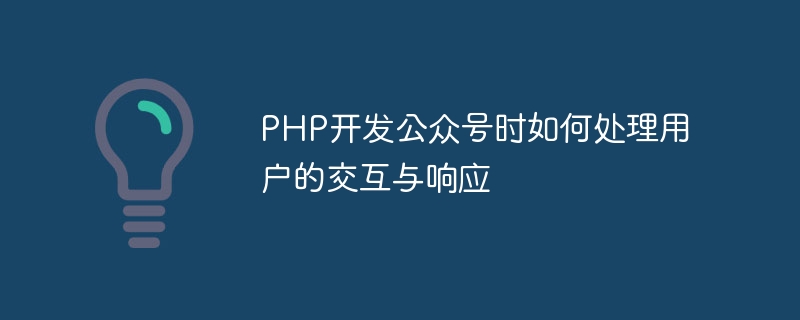

How to handle user interaction and response when developing public accounts in PHP
As an important social media tool, more and more companies and individuals are starting to use public accounts Use public accounts for promotion, fan interaction and information transmission. In public account development, PHP, as a commonly used server-side scripting language, provides us with rich syntax and functions that can help us handle user interaction and response. Next, I will use specific code examples to introduce how to handle user interaction and response when developing public accounts using PHP.
The main way for users to interact with public accounts is to send messages through the interface provided by the WeChat platform. We can use PHP's $_POST or $_GET super global variables to receive these interactive information from the WeChat platform. Taking receiving text messages as an example, the code is as follows:
//接收文本消息
$input = file_get_contents("php://input");
$xml = simplexml_load_string($input);
$fromUser = $xml->FromUserName; //发送消息的用户openid
$content = $xml->Content; //文本消息内容In the above code, we obtain the XML format information sent by the WeChat platform through the file_get_contents function, convert it into a simple object through the simplexml_load_string function, and then use properties of an object to access its contents.
After receiving the user's interactive information, we need to process it accordingly according to the user's request. Specific processing logic can be defined according to actual needs. For example, we can perform different processing by judging the text content sent by the user. The following is a simple example:
//处理文本消息
switch ($content) {
case '1':
//回复文本消息
$content = "您发送了数字1";
echo generateReplyMessage($fromUser, $content);
break;
case '2':
//回复图文消息
echo generateNewsMessage($fromUser);
break;
default:
//默认回复
$content = "您发送了其他消息";
echo generateReplyMessage($fromUser, $content);
break;
}In the above code, we use the switch statement to determine different processing logic based on the text content sent by the user. Depending on the situation, we can call different functions to generate different types of reply messages. The generateReplyMessage function is used to generate text message replies, and the generateNewsMessage function is used to generate graphic message replies.
After we process the user's interaction request, we need to return the reply message to the WeChat platform so that the platform can send it to the user. In order to facilitate the generation of reply messages, we can define some functions to help us generate different types of reply messages. The following is an example:
//生成文本消息回复
function generateReplyMessage($toUser, $content) {
$template = "<xml>
<ToUserName><![CDATA[%s]]></ToUserName>
<FromUserName><![CDATA[%s]]></FromUserName>
<CreateTime>%s</CreateTime>
<MsgType><![CDATA[text]]></MsgType>
<Content><![CDATA[%s]]></Content>
</xml>";
$time = time();
return sprintf($template, $toUser, $content, $time);
}
//生成图文消息回复
function generateNewsMessage($toUser) {
$template = "<xml>
<ToUserName><![CDATA[%s]]></ToUserName>
<FromUserName><![CDATA[%s]]></FromUserName>
<CreateTime>%s</CreateTime>
<MsgType><![CDATA[news]]></MsgType>
<ArticleCount>1</ArticleCount>
<Articles>
<item>
<Title><![CDATA[PHP开发公众号]]></Title>
<Description><![CDATA[利用PHP开发公众号]]></Description>
<PicUrl><![CDATA[图片地址]]></PicUrl>
<Url><![CDATA[跳转链接]]></Url>
</item>
</Articles>
</xml>";
$time = time();
return sprintf($template, $toUser, $time);
}In the above code, we define two functions, which are used to generate text message replies and graphic message replies. We can modify the template content according to actual needs to generate a reply message that meets the requirements.
To sum up, the above are some methods for handling user interaction and response when using PHP to develop public accounts. By receiving user interaction information, processing user interaction requests, and generating reply messages, we can realize interaction and information transfer between official accounts and users. Of course, the specific implementation will vary depending on project requirements. The above code is only an example, and developers can make corresponding adjustments and extensions based on actual conditions.
The above is the detailed content of How to handle user interaction and response when developing public accounts in PHP. For more information, please follow other related articles on the PHP Chinese website!
 The difference between WeChat service account and official account
The difference between WeChat service account and official account
 What are the differences between hibernate and mybatis
What are the differences between hibernate and mybatis
 What is j2ee
What is j2ee
 The difference between MATE60 and MATE60PRO
The difference between MATE60 and MATE60PRO
 oracle cursor usage
oracle cursor usage
 What does mesh networking mean?
What does mesh networking mean?
 Server monitoring software
Server monitoring software
 vlookup matches two columns of data
vlookup matches two columns of data
 How to set both ends to be aligned in css
How to set both ends to be aligned in css